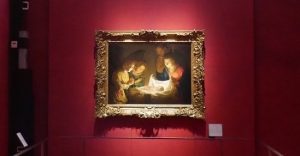New Uffizi Rooms Dedicated to Caravaggio & Baroque Art
 In honor of the 275th anniversary of Anna Maria Luisa de’Medici’s death on February 18, who willed her family’s art collection that became the Uffizi Gallery, Florentine museums celebrated the importance of the Medici family with special shows, opening times, and new exhibits.
In honor of the 275th anniversary of Anna Maria Luisa de’Medici’s death on February 18, who willed her family’s art collection that became the Uffizi Gallery, Florentine museums celebrated the importance of the Medici family with special shows, opening times, and new exhibits.
The Uffizi inaugurated eight new rooms on February 19, devoted to Caravaggio and accompanying 17th century paintings. The director of the Uffizi, Eike Schmidt, wants to show Florentines and visitors alike that there is a continued importance given to innovation and the future of the Uffizi through the opening of the new rooms. Finally united in one area are pieces from the 17th century and Baroque period. The Baroque period was highly fueled by the Catholic church insisting art and architecture be in contrast to the no-frills, relatively unadorned Protestant works of the time. Key characteristics in Baroque art include extreme detail and occasional hyperbole, fluid and wavy lines, and a dramatic use of light and dark to emphasize intensity.
The new space, headlined by Caravaggio’s Medusa, is aimed to “create an intellectual experience” for all of its visitors according the Schmidt. The red hued walls aim to bring visitors into the world of 17th century private collectors, such as the Medici. The display juxtaposes local paintings with works from the rest of Europe, in a beautiful show of “international spirit.”
The eight rooms all have their own unique name, in order to evoke thought and emotion as well as the exhibits contained therein. They are: Between Reality and Magic; Caravaggio and Artemisia; Caravaggio: Medusa; Caravaggio: Bacchus; By Candlelight; Rembrandt and Rubens; Galileo and the Medici; and Florentine Epic. Major works include Artemisia Gentileschi’s Beheading of Holofernes and Caravaggio’s Bacchus. (jane kuntz)
